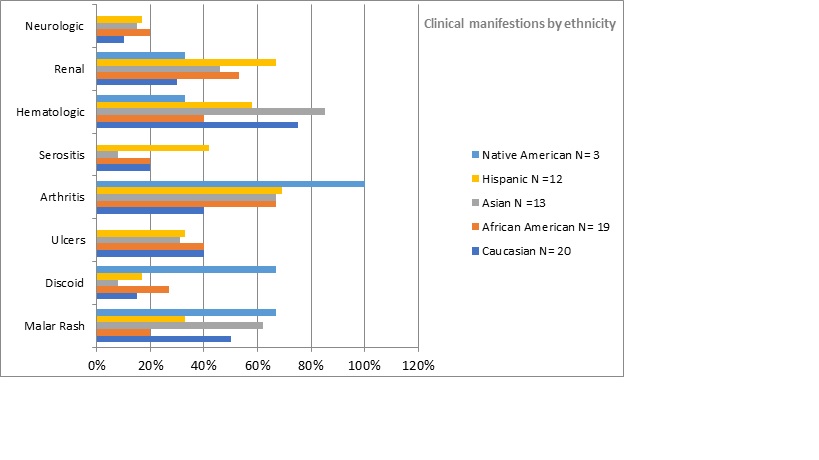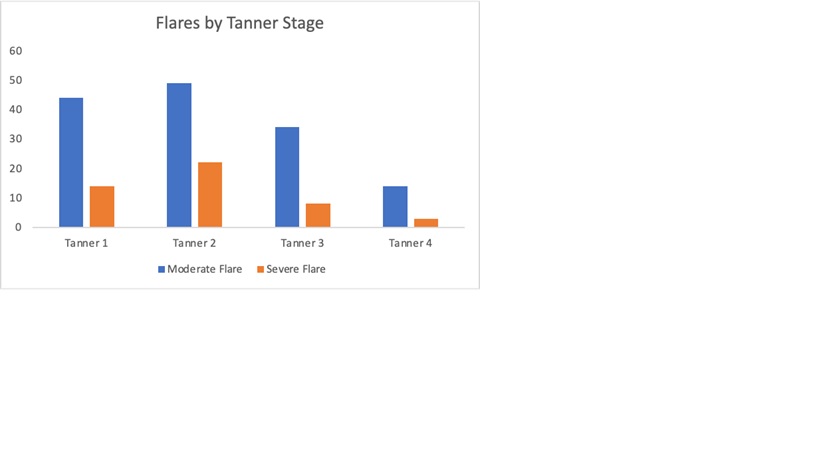Session Information
Date: Monday, November 8, 2021
Title: SLE – Diagnosis, Manifestations, & Outcomes Poster III: Outcomes (1257–1303)
Session Type: Poster Session C
Session Time: 8:30AM-10:30AM
Background/Purpose: Pediatric Onset SLE is associated with higher disease activity and higher risk of damage. There is limited information on prepubertal patients with SLE and how disease activity varies throughout puberty. With the increasing life expectancy and yet subsequent cumulative damage it is paramount to characterize the clinical manifestations, disease activity, organ damage and quality of life in these patients. The aims of this study are to describe the clinical characteristics, disease activity pattern, frequency and classification of flares and organ damage of patients with prepubertal onset SLE and to evaluate the association of disease outcome as they relate to pubertal progress and hormonal changes.
Methods: This database represents 63 subjects (51 girls and 12 boys) from 12 CARRA sites followed every 3 months from late pre-puberty through completion of maturation process or study completion. Collected data included comprehensive medical history, physical examination findings, Tanner stage, SLEDAI-2k activity scores and MD-global assessments. Analytes measured in serum: Sex Hormones – Prolactin, estradiol, testosterone; adipose derived hormones Adipokines – leptin, adiponectin, resistin, visfatin. Flares were determined by SELENA-SLEDAI flare index. Two generalized estimating equations were calculated using SLEDAI and PGA as predictors in two different models. Multivariable models were adjusted for possible confounders.
Results: A total of 484 follow-up visits were included. Mean length of study involvement was 21 months. Arthritis, hematologic and renal manifestations were predominant among this group of subjects. Results of the of GEE analysis of hormones predicting disease activity indicated the main effects of adiponectin (Wald c2 = 14.25, p < .001) and estradiol (Wald c2 = 6.04, p < .01) significantly predicted disease activity as measured by the SLEDAI. Interactions between Tanner stage and adiponectin (Wald c2 = 22.64, p< .001) and Tanner stage and Estradiol (Wald c2 = 7.187, p< .001) predicted disease activity as indicated by higher SLEDAI scores. In our second model, the main effects of leptin (Wald c2 = 8.14, p < .01), adiponectin (Wald c2 = 15.88, p < .001), visfatin (Wald c2 = 9.61, p < .001), and progesterone (Wald c2 = 12.64, p < .001) predicted disease activity as indicated by PGA scores.
Conclusion: The activity level of SLE and risk of disease flare rise as soon as the first signs of puberty are apparent, a time referred to as the start of Tanner 2. Changes of adiponectin and estradiol significantly predicted disease activity as measured by the SLEDAI. Disease activity and flare risk declined once the child was sexually mature. Treatment algorithms based on these factors may help to improve long-term outcomes in childhood SLE.
 Clinical manifestation by ethnicity.JPEGClinical manifestations by ethnicity
Clinical manifestation by ethnicity.JPEGClinical manifestations by ethnicity
To cite this abstract in AMA style:
Rodriguez M, Johnson K, O'Neil K. Clinical Characteristics of Patients with Pre-pubertal Onset SLE and Disease Outcome Throughout Puberty: A Multicenter North American Longitudinal Study [abstract]. Arthritis Rheumatol. 2021; 73 (suppl 9). https://acrabstracts.org/abstract/clinical-characteristics-of-patients-with-pre-pubertal-onset-sle-and-disease-outcome-throughout-puberty-a-multicenter-north-american-longitudinal-study/. Accessed .« Back to ACR Convergence 2021
ACR Meeting Abstracts - https://acrabstracts.org/abstract/clinical-characteristics-of-patients-with-pre-pubertal-onset-sle-and-disease-outcome-throughout-puberty-a-multicenter-north-american-longitudinal-study/


